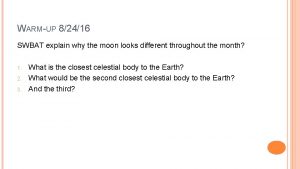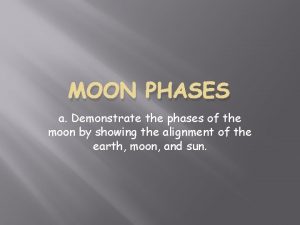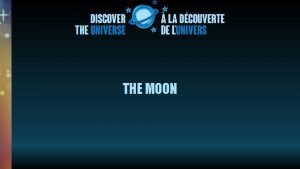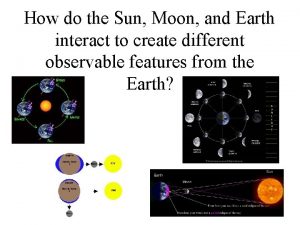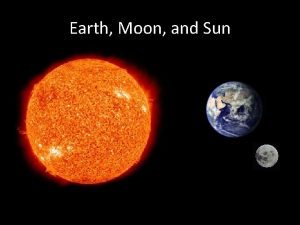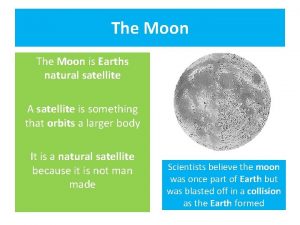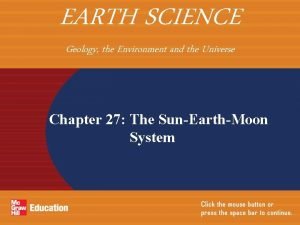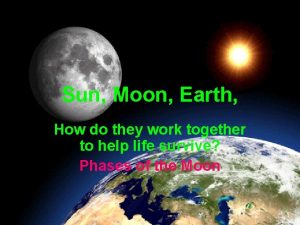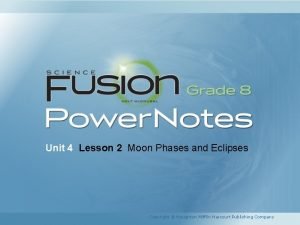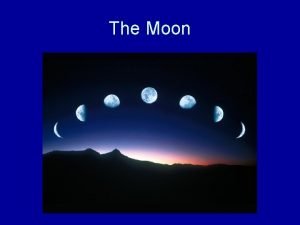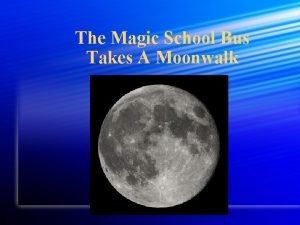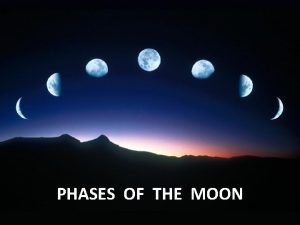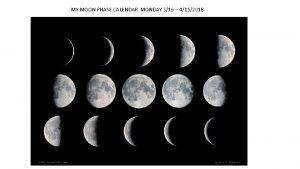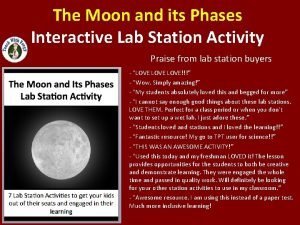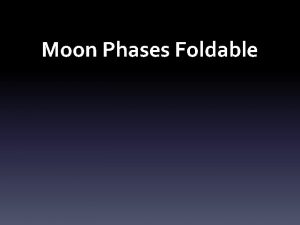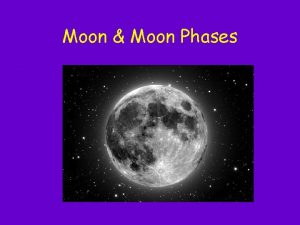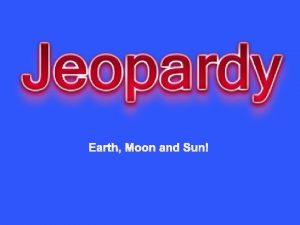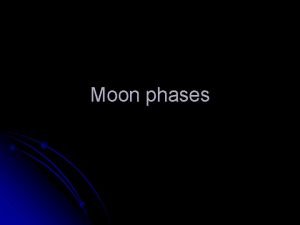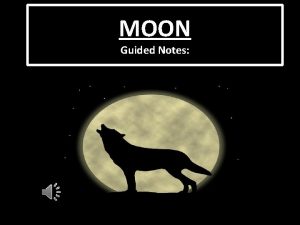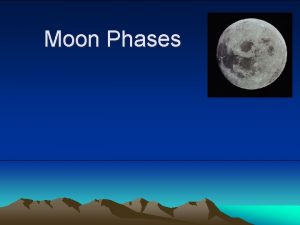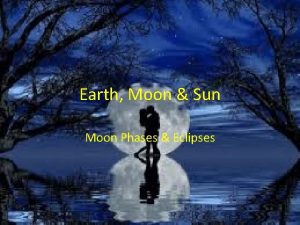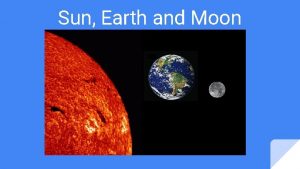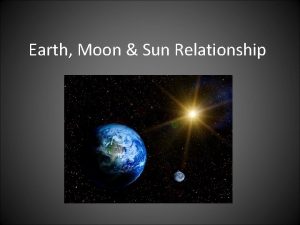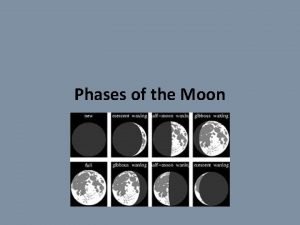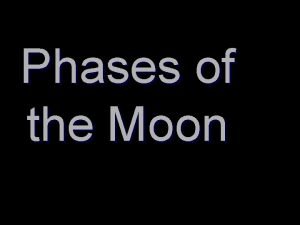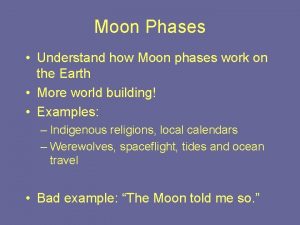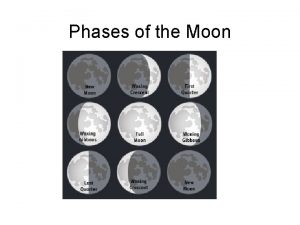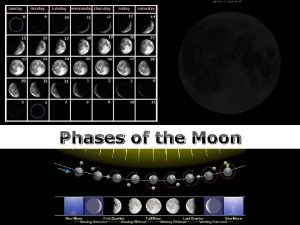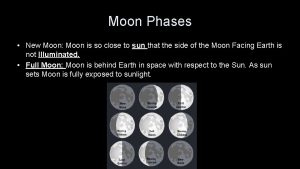Unit 9 Earth Sun Moon Phases moon 1




















- Slides: 20

Unit 9: Earth, Sun, & Moon Phases

moon 1. The ____ is Earth’s only natural satellite. It is also Earth’s closest neighbor in space.

gravitational, inertia 2. Moons orbit planets for the same reason that planets orbit the Sun--because of ____ attraction and ______.

tides 3. The Moon’s gravitational force causes Earth’s ______, the regular rise and fall of water levels along the shore.

revolution, 365 1/4 4. Earth is moving at 30 km/s (19 mi/s) as it orbits the Sun. A _____________ is a complete pass around the Sun, taking __________ days, or one year.

axis, rotation 5. Earth is also spinning on the ____ at about 1600 km/h (1000 mph). One _______ is a complete spin on the axis.

24 6. Earth makes one rotation every day or _______ hours.

daylight, darkness 7. At any point in time, half of Earth’s surfaces the Sun and is in _______. The other half of Earth’s surfaces away from the sun and is in _____.

tilt 8. The _________ of Earth’s axis affects the lengths of the day. If the axis were not tilted, day and night would each be 12 hours long.

east, west 9. If you watch objects in the sky, such as the Sun, they appear to rise in the ________, move across the sky, and set in the _______. The Sun is not actually moving though.

Apparent motion, rotation 10. _______ is the way something appears, or seems, to move. Earth’s ________ causes the apparent motion of many objects in space.

revolves, orbit 11. Earth ____________ around the Sun. To revolve means to move around an object. The path a revolving object follows is its __________.

ellipse 12. Earth’s orbit is shaped like an _____, or a slightly flattened circle.

seasons 13. Recall that Earth’s axis is tilted and it takes 365 ½ days to make a full revolution. The _______ result from both Earth’s tilted axis and its revolution around the Sun.

winter, summer 14. As Earth revolves around the Sun, the tilted axis points in the same direction. When the Northern Hemisphere is tilted away from the Sun, it is _____ in the Northern Hemisphere. At the same time, it is _______ in the Southern Hemisphere because it is angled toward the Sun.

opposite 15. Because the tilt of Earth’s axis always points in the same direction, the seasons in the Northern and Southern Hemispheres are always ___________.

dos not, sun 16. Unlike stars, the Moon _____________ make its own light, it reflects the light from the _____.

29, month 17. The Moon completes one orbit in just over _____ days. This is almost as long as an average ______.

phases 18. During the Moon’s orbit, we see different amounts of the moon lit by the Sun. The apparent shapes of the Moon in the sky are called ___________. The Moon cycles through all of its phases during one complete orbit.

waxing, waning, new moon As the Moon appears to get larger, it is ______. As it appears to get smaller, it is _____. During the __________ phase, the Moon cannot be observed at all.
 Phases of the moon sun on left
Phases of the moon sun on left Moon phases when the sun is on the left
Moon phases when the sun is on the left Andreu cardo martinez
Andreu cardo martinez How does the sun moon and earth work together
How does the sun moon and earth work together Lesson outline lesson 3 eclipses and tides answer key
Lesson outline lesson 3 eclipses and tides answer key What season is this
What season is this Earth sun and moon relationships
Earth sun and moon relationships Pictures of other planets
Pictures of other planets Whats a natural satellite
Whats a natural satellite Earth moon
Earth moon How does the sun moon and earth work together
How does the sun moon and earth work together Lesson 2 moon phases and eclipses answer key
Lesson 2 moon phases and eclipses answer key During which phase of the moon do neap tides occur
During which phase of the moon do neap tides occur Magic school bus moon phases
Magic school bus moon phases Northern hemisphere moon phases
Northern hemisphere moon phases Hawaiian moon phases
Hawaiian moon phases Moon phases gif
Moon phases gif What causes the phases of the moon
What causes the phases of the moon Which best explains why the moon has phases
Which best explains why the moon has phases Moon phases interactive notebook
Moon phases interactive notebook Moon phases foldable
Moon phases foldable
